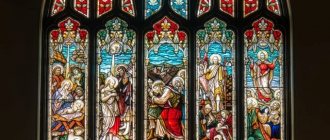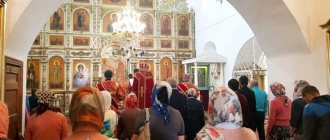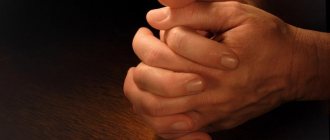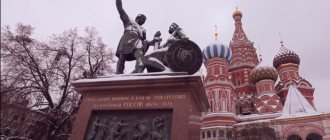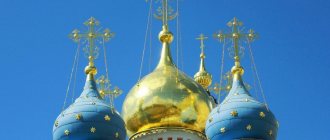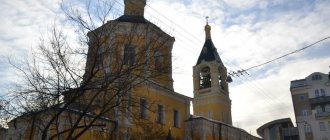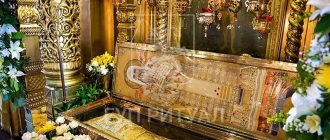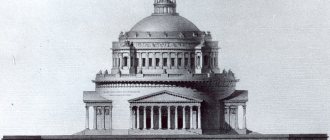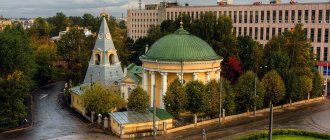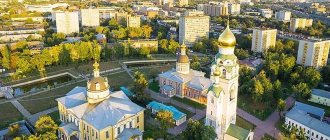Quadripartite icons are four different icons, each with its own subject, painted on one board. It is not known exactly when such icons appeared in Rus', but in Novgorod in the 15th century there were already icons of this type.
As a rule, such an icon is divided in the center by a crucifix depicting the face of Christ or His crucified figure. Most often, an icon with a crucifix depicts the deeds of saints, when each of the four icons depicts some moment of their life and deed.
One of the most famous is the four-part icon of the Mother of God called “Motherhood”. It depicts the Mother of God holding the Baby Jesus in her arms at different moments of His infancy and childhood. This is an icon of Byzantine writing; it is assumed that it was written in the 6th century, but in Rus' it was discovered only in the second half of the 17th century near Minsk. Legend has it that the icon was found on a tree. Later, at the site where the icon was found, a temple was erected in honor of the Dormition of the Blessed Virgin Mary.
Description of the four-part icon of the Mother of God
Even if compared with ordinary icons, the icon of the Mother of God is quite rare. If they start talking about four-part icons, they first of all remember the “Motherhood” icon. It looks like this.
In the lower left part there is the “Leaping of the Child” icon, depicting the Child Jesus playing with his Mother. She carefully holds him in her arms, and He presses his cheek to Her face and strokes it with his hand.
In the lower right part there is the “Education” icon, where Jesus is in the arms of the Mother, raising his hand, apparently saying something, and the Mother listens to him, bowing her head.
In the upper left part there is the “Mammal” icon. This is a chaste image of how the Mother of God feeds the Divine Child with her milk.
In the upper right part there is an icon “Helping Childbirth”, where the Mother of God holds in front of her, like a shield, a symbolic image of a child in the womb.
In the center is a crucifix with the face of Jesus Christ.
It is noteworthy that on the icon “Helping Childbirth” the Mother of God is depicted with her head uncovered, as befits a girl, while on all the other three icons her head is covered, as married women traditionally wore.
And you can’t help but notice how sad her face is. Usually mothers look at their little children with a smile, but this Mother knows what torment awaits her Son, and therefore her gaze is filled with sadness and submission to the Will of God.
Icon “Four-Part (Four Days)” - icon painting workshops in Moscow
Description of the icon.
The “Four-Part” icon was found in 1919 by art historian, restorer, and later by Honored Cultural Worker, Nikolai Nikolaevich Pomerantsev in the Moscow Kremlin, on the bell tower of Ivan the Great. It entered the collection of the Tretyakov Gallery from the State Historical Museum in 1930.
The icon is painted on a wooden board measuring 20.5 × 14.5 cm (mortise key on the back), with egg tempera on gesso. Pavolok is specially made, with a ribbed and herringbone pattern of threads.
Iconographically, the image belongs to the category of complex compositions; by the type of image, it belongs to a plot composition with marks. Four equal-sized parts (stamps) of the icon are separated by edges. The upper left stamp depicts John the Baptist in the desert (Luke 1:80), bending over a bowl containing his severed head. He extends his right hand and holds a cross and a scroll in his left. On the unfolded scroll is written a text calling for repentance. The upper right stamp depicts the Mother of God with the Child on her lap, sitting on a throne. (Luke 1:28; Luke 1:42). Next to Her are the archangels Gabriel (Dan.8:16; Dan.9:21; Luke 1:19; Luke 1:26) and Michael (Dan.10:13; Dan.10:21; Dan.12:1 ; Dan.3:95; Num.22:22; Joshua 5:14; 2 Kings 19:35), standing with their heads bowed and hands extended to the throne.
The lower left stamp shows (without halos) standing apostles, prophets and saints. Experts suggest here images of the apostles Peter, Paul and Andrew, the prophets Samuel, Moses, David, Solomon, Daniel, Ananias, Azarias, Misail, Saints John Chrysostom, Basil the Great, Nicholas of Myra, Metropolitan Peter, Isaiah, Leontius. The stamp on the right depicts martyrs and martyrs, they are headed by Archdeacon Stefan, then, presumably, George, Demetrius, Roman, Varvara, Paraskeva, Thekla, Mary Magdalene, Queens Alexandra and Catherine, Prince Joasaph, Onuphrius the Great. (3 Macc.6:29; 1 Cor.12:28). Below, at the feet of the Saints, the dead are depicted in shrouds, rising from their coffins and stretching out their hands to them.
The small size of the figures does not negate the techniques of monumental painting of that time. The colors of the icon are thick and bright. The colors are mainly greenish-blue, olive, lilac-brown, cinnabar and ocher in separate spots. A swirl of white and light ocher over dark brown sankir, the transitions from light to shadow are clear. The background is golden, on it are the remains of cinnabar inscriptions with the names of individual figures, the ground is pinkish. The assist was made by scratching with a thin sharp object through the paint to gold.
The four-part icon was restored several times: in the 1920s at the Commission by I.A. Baranov (upper left stamp), the lower stamps were revealed by him in the State Tretyakov Gallery in 1949 - 1950, in 1959 - 1960 in the State Central Artistic Museum by E.I. Petrenko - Baranova, under the leadership of N.N. Pomerantsev, the last, upper right mark was revealed.
History of the image.
The four-part icon (“Four Days”) was considered as an illustration of the services of Great Lent. Great Lent is the fast before Easter, from Monday in the first week to Friday in the sixth. The plot of the icon is connected specifically with the Great Pentecost, since among its marks (on the upper left) there is an image of John the Baptist and his head. The finding of the Head usually occurs during Lent.
The upper right stamp depicts the Mother of God on a throne with bowing archangels, since on Saturday of the fifth week of Great Lent an akathist to the Mother of God is read. On Saturday, during the 2nd, 3rd and 4th weeks, prayers are offered to all the saints depicted on the lower marks of the icon. Also, during the “Meat Empty Week,” the Last Judgment is remembered - the dead rising from their coffins on the lower right stamp. (K. Nikolsky, A manual for the study of the rules of worship of the Orthodox Church, St. Petersburg, 1907).
Features of the Moscow icon painting school of the 14th - 15th centuries.
Moscow icon painting of the first half of the 14th century combined various artistic movements - local, Byzantine, South Slavic. A turning point began in the 40s of the 14th century, after the arrival of Constantinople painters invited to Moscow by Metropolitan Theognostus. At the end of the century, the “Byzantine” trend sharply intensified, this is due to the appearance of Theophanes the Greek in Moscow. His painting style is distinguished by emotional tension, expressed in the enhanced dynamics of poses, gestures and even folds of clothing. Icon painters began working with a master of great talent, who contributed to raising the level of the Moscow school.
With the appearance of Andrei Rublev, the most significant chapter in the history of Moscow icon painting begins. He managed to combine local traditions and the best of the painting techniques of Byzantine masters. The basis of Andrei Rublev’s creativity is goodness and beauty, a harmonious combination of spiritual and material principles. His “Savior” is not a merciless judge, but a loving and all-forgiving God. The pinnacle of Rublev’s creativity, like all ancient Russian painting, was the “Trinity”, which is a symbol of Good, Sacrifice and Love. His ideals are enlightened, his painting is calm and contemplative. He deliberately replaces the Byzantine over-refinement of forms with simplicity. Harmonious combinations of poses, a calm palette, and roundness of shapes create the impression of unity and coherence. The works of this period are marked by clarity and harmony, pictorial transparency and softening of images, which can be traced in the further development of the school.
Throughout the 15th century, this style remained leading. Theophanes the Greek and Andrei Rublev were the most prominent representatives of Moscow icon painting, it was thanks to them that it flourished and also managed to annex the Novgorod and Pskov schools. After the death of Andrei Rublev, his painting traditions were preserved, but a higher level of art was still not achieved. Followers of the Rublev movement paid attention not so much to the spiritual content of the images, but to their external features - the lightness of the figures, the use of smooth lines in painting faces, and the creation of a contrasting color scheme.
Another characteristic feature of the Moscow school of icon painting of that time was the introduction of real canonized secular and clergy figures into a number of iconographic images and subjects.
Author of the text: Marina Rumyantseva.
The meaning of the four-part icon of the Mother of God with the crucifix
One can rightfully say that the four-part icon of the Mother of God is an icon primarily for women, because it depicts the most important thing in the life of every woman - motherhood, and it is not for nothing that the icon received such a name.
The icon protects mother and child even before it is born
While the child is in the mother’s womb, the icon protects them both from adversity, and then, when the due date comes, it helps the mother in labor during a difficult birth.
“Motherhood”, a four-part icon with a crucifix, the meaning of which is clear without words, should be in the home of every woman. It is often given to girls getting married or women expecting a child, especially their first child. But regardless of whether a woman has children or not, such an icon will become a talisman and protection for her - protection from everything that could harm her family and children.
It doesn’t matter in what style it is written, this list in any case corresponds to the Orthodox church canons. Before her they pray for the health of children and relatives, and the prayer “Living Help” helps pregnant women bear a child without complications. It is best to give a four-part icon of the Mother of God on the Nativity of the Virgin Mary and on the Dormition of the Virgin Mary, or on the date of celebration of the icon - January 25. On this day you need to pray for the health of your children and parents.
Description of the icons of the intercessors of Russia
According to legend, the first images of the Mother of God were painted by the Evangelist Luke during his lifetime, and he painted the Vladimir Icon on the table in the refectory of Jesus.
In Orthodox iconography, there are several types of images of the Mother of God: Oranta (Praying), Hodegetria (Conductor), Eleusa (Tenderness), Panachranta (Merciful), etc.
In Russian iconography of the Mother of God, some canons of her images have been developed: the most famous icons of Russia represent the Most Holy Theotokos, often with the Child Jesus on her lap, in the form of a beautiful woman with a face full of mourning or enlightened pain, in which we can read humility, but at the same time time spiritual strength.
one cannot fail to mention other icons of the Mother of God revered in Rus': Don, Kursk-Root, Feodorovskaya, Pskov-Pecherskaya, as well as “The Sign”, “The Hearing One”, “Seven Blows”, “Quench My Efforts”, “Three Joys” and a lot others.
It should be remembered that prayer in front of any icon is a request to the saint depicted on it to convey our prayer request to the Lord, therefore the icon of the Savior invariably occupies a prominent place both in churches and in home iconostases.
The most famous icons of especially revered saints
In the Orthodox tradition, the idea is that many saints help in certain situations. Therefore, they pray to the Great Martyr Panteleimon the Healer for healing from diseases; about strong family ties - Murom residents Peter and Fevronia; Ns. Ksenia Petersburgskaya - about a successful marriage; Ns. Vasily - about success in business and solving financial problems; Ns. Matrona of Moscow - about the successful solution of housing problems and other everyday problems; Ns. Anna - about healing from infertility.
In addition, famous icons help those who were baptized in the name of the saint, who became their heavenly protector, so quite rare icons can be found even in Orthodox homes.
A prayer in front of an icon, even the most famous one, should contain not only requests, but also gratitude, praise to the Lord and the saint on the icon for the mercy shown to us. Holy images act as intermediaries between those praying and the Holy Trinity, the only one given the power to offer prayers by faith.
Over the long centuries after their acquisition, many icons acquired the glory of the miraculous thanks to the miraculous healings they revealed, protection from enemies, fires and epidemics. Science has not been able to explain the miracle of the flow of myrrh, which appears in many icons, but this miraculous world still heals and serves as confirmation that an icon is not just a beautiful image.
